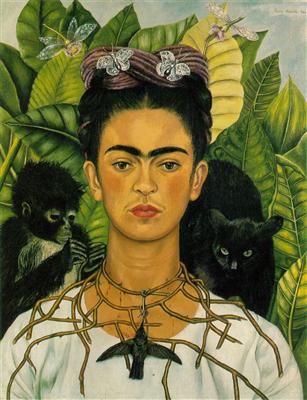
“I paint self-portraits because I am so often alone, because I am the person I know best.”
-Frida Kahlo
Frida Kahlo was a very important figure in art and best known for her colourful self-portraits which explore themes of identity, the human body, and death. While she never considered herself to be a surrealist, she is often identified as one. She brings a strong cultural element into her work, inspired by nature and artifacts of Mexico, and explores questions of gender, class and race in Mexican society.
Frida Kahlo (full name Frida Kahlo de Rivera) was born on July 6th, 1907 in Coyoacan, Mexico and died in the same town on July 13th, 1954. Kahlo’s father was German and of Hungarian descent. Kahlo was closer to him, and would help him in his photography studio, where she developed an eye for detail. As a child, Kahlo suffered from polio which left her with a slight limp and this affected her later in life.
While Kahlo took a few drawing classes at school, Kahlo was more interested in science and in 1922 she entered the National Preparatory School in Mexico City with the hopes in eventually studying medicine. It was there were she met artist Diego Rivera, who was working on a mural for the school’s auditorium.
In 1925, Kahlo was involved in a bus accident, which seriously injured her and as a result had to undergo over 30 medical operations in her life. It was during her slow recovery that Kahlo taught herself to paint, and she studied from the works of the Old Masters. After recuperating, she joined the Mexican Communist Party (PCM), where she met Rivera once again. She showed him some of her work and he encouraged her to keep on painting.
Down below is an example of one of her early works, Self-Portrait Wearing a Velvet Dress (1926). She painted herself against a dark background with stylized waves and while this work is mostly abstract, their is realism in the modelling of her face. Her long neck and fingers is inspired by Mannerist painters and her stoic gaze is also a signature aspect which is present in her other works.
Kahlo later married Rivera in 1929, and she changed both her personal and painting style. She began to wear the traditional Tehuana dress along with a flowered headdress that became part of her trademark. This also showed her new interest in Mexican folk art. Kahlo’s relationship with Rivera was tumultuous and in the mid 1930s there were numerous extramarital affairs that were happening. The same year Kahlo painted some of her most famous works, including The Two Fridas which was painted on a large canvas and shows twin figures holding hands each figure representing an opposing side of Kahlo.

Kahlo later reconciled with Rivera in 1940 and the couple moved into her childhood home, La Casa Azul (The Blue House), in Coyoacan. Kahlo’s health at this point would further continue to decline and she would turn to drugs and alcohol for relief. She still continued to paint, however. She died in La Casa Azul in 1954, the cause being pulmonary embolism.
Kahlo became a female role model for many artists to follow as she made it legitimate for women to outwardly display their pains. I remember reading a book about Frida Kahlo when I was in High School and admired her as an artist. I like the way she isn’t afraid to speak up her mind and the fact that she was so resilient and kept painting despite all the struggles and hardships she faced. I found her biography to be very inspirational.
Works Cited:
Leave a Reply